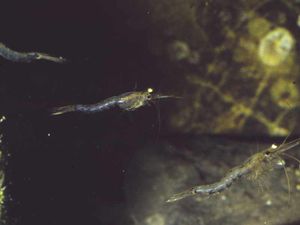Difference between revisions of "Effects of endocrine disrupting compounds on embryonic development of opossum shrimps."
(→References) |
m |
||
| Line 5: | Line 5: | ||
<u>'''Context of the study'''</u> | <u>'''Context of the study'''</u> | ||
| − | Methoprene is an insect regulator used against | + | Methoprene is an insect regulator used against mosquitoes. It interacts with the [[endocrine system]] of the mosquitoes and impairs their development. However, it is suspected that crustacean invertebrates (like opossum shrimp) might also be sensitive to this [[endocrine disrupting compounds|endocrine disrupting compound]]. It might affect the shrimp in its embryonic stages.<ref name="pub">[http://www.vliz.be/imis/imis.php?module=ref&refid=105302 Ghekiere, A.; Fockedey, N.; Verslycke, T.; Vincx, M.; Janssen, C.R. (2007). Marsupial development in the mysid Neomysis integer (Crustacea: Mysidacea) to evaluate the effects of endocrine-disrupting chemicals. Ecotoxicol. Environ. Saf. 66(1): 9-15]</ref> |
'''<u>Content of the study</u>''' | '''<u>Content of the study</u>''' | ||
| − | Environmental concentrations of methoprene range between 0,39 and 8,8 µg/l. This study investigated the | + | Environmental concentrations of methoprene range between 0,39 and 8,8 µg/l (ref?). This study investigated the impact of 0,01 µg/l, 1µg/l and 100µg/l of methoprene on the embryonic development of opossum shrimp. This was the first study which investigated the effects of an endocrine disrupting compound on the embryonic development of opossum shrimps. |
<u>'''Main results of the study'''</u> | <u>'''Main results of the study'''</u> | ||
| − | Egg survival rate (the percentage of eggs which survive | + | Egg survival rate (the percentage of eggs which survive one day) was higher in the control (0µg/l methoprene) and the 0,01 µg/l methoprene samples than in the 1µg/l methoprene and 100µ/l methoprene samples. The biggest effects were seen on hatching success: 59.7%, 47.8%, 40.2% and 23.3%, for the control sample, 0,01 µg/l, 1µg/l and 100µg/l methoprene respectively. |
The study concluded that methoprene interferes with the embryonic of development opossum shrimps. <ref name="pub">[http://www.vliz.be/imis/imis.php?module=ref&refid=105302 Ghekiere, A.; Fockedey, N.; Verslycke, T.; Vincx, M.; Janssen, C.R. (2007). Marsupial development in the mysid Neomysis integer (Crustacea: Mysidacea) to evaluate the effects of endocrine-disrupting chemicals. Ecotoxicol. Environ. Saf. 66(1): 9-15]</ref> | The study concluded that methoprene interferes with the embryonic of development opossum shrimps. <ref name="pub">[http://www.vliz.be/imis/imis.php?module=ref&refid=105302 Ghekiere, A.; Fockedey, N.; Verslycke, T.; Vincx, M.; Janssen, C.R. (2007). Marsupial development in the mysid Neomysis integer (Crustacea: Mysidacea) to evaluate the effects of endocrine-disrupting chemicals. Ecotoxicol. Environ. Saf. 66(1): 9-15]</ref> | ||
Revision as of 10:40, 3 June 2013
Context of the study
Methoprene is an insect regulator used against mosquitoes. It interacts with the endocrine system of the mosquitoes and impairs their development. However, it is suspected that crustacean invertebrates (like opossum shrimp) might also be sensitive to this endocrine disrupting compound. It might affect the shrimp in its embryonic stages.[1]
Content of the study
Environmental concentrations of methoprene range between 0,39 and 8,8 µg/l (ref?). This study investigated the impact of 0,01 µg/l, 1µg/l and 100µg/l of methoprene on the embryonic development of opossum shrimp. This was the first study which investigated the effects of an endocrine disrupting compound on the embryonic development of opossum shrimps.
Main results of the study
Egg survival rate (the percentage of eggs which survive one day) was higher in the control (0µg/l methoprene) and the 0,01 µg/l methoprene samples than in the 1µg/l methoprene and 100µ/l methoprene samples. The biggest effects were seen on hatching success: 59.7%, 47.8%, 40.2% and 23.3%, for the control sample, 0,01 µg/l, 1µg/l and 100µg/l methoprene respectively. The study concluded that methoprene interferes with the embryonic of development opossum shrimps. [1]
References
Please note that others may also have edited the contents of this article.
|

